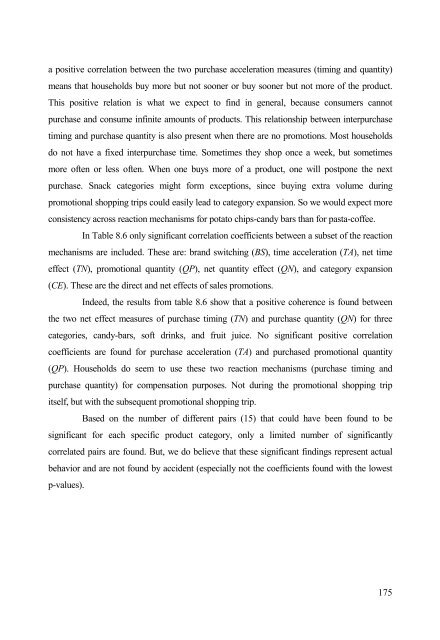Analysis of Sales Promotion Effects on Household Purchase Behavior
Analysis of Sales Promotion Effects on Household Purchase Behavior
Analysis of Sales Promotion Effects on Household Purchase Behavior
Create successful ePaper yourself
Turn your PDF publications into a flip-book with our unique Google optimized e-Paper software.
a positive correlati<strong>on</strong> between the two purchase accelerati<strong>on</strong> measures (timing and quantity)<br />
means that households buy more but not so<strong>on</strong>er or buy so<strong>on</strong>er but not more <str<strong>on</strong>g>of</str<strong>on</strong>g> the product.<br />
This positive relati<strong>on</strong> is what we expect to find in general, because c<strong>on</strong>sumers cannot<br />
purchase and c<strong>on</strong>sume infinite amounts <str<strong>on</strong>g>of</str<strong>on</strong>g> products. This relati<strong>on</strong>ship between interpurchase<br />
timing and purchase quantity is also present when there are no promoti<strong>on</strong>s. Most households<br />
do not have a fixed interpurchase time. Sometimes they shop <strong>on</strong>ce a week, but sometimes<br />
more <str<strong>on</strong>g>of</str<strong>on</strong>g>ten or less <str<strong>on</strong>g>of</str<strong>on</strong>g>ten. When <strong>on</strong>e buys more <str<strong>on</strong>g>of</str<strong>on</strong>g> a product, <strong>on</strong>e will postp<strong>on</strong>e the next<br />
purchase. Snack categories might form excepti<strong>on</strong>s, since buying extra volume during<br />
promoti<strong>on</strong>al shopping trips could easily lead to category expansi<strong>on</strong>. So we would expect more<br />
c<strong>on</strong>sistency across reacti<strong>on</strong> mechanisms for potato chips-candy bars than for pasta-c<str<strong>on</strong>g>of</str<strong>on</strong>g>fee.<br />
In Table 8.6 <strong>on</strong>ly significant correlati<strong>on</strong> coefficients between a subset <str<strong>on</strong>g>of</str<strong>on</strong>g> the reacti<strong>on</strong><br />
mechanisms are included. These are: brand switching (BS), time accelerati<strong>on</strong> (TA), net time<br />
effect (TN), promoti<strong>on</strong>al quantity (QP), net quantity effect (QN), and category expansi<strong>on</strong><br />
(CE). These are the direct and net effects <str<strong>on</strong>g>of</str<strong>on</strong>g> sales promoti<strong>on</strong>s.<br />
Indeed, the results from table 8.6 show that a positive coherence is found between<br />
the two net effect measures <str<strong>on</strong>g>of</str<strong>on</strong>g> purchase timing (TN) and purchase quantity (QN) for three<br />
categories, candy-bars, s<str<strong>on</strong>g>of</str<strong>on</strong>g>t drinks, and fruit juice. No significant positive correlati<strong>on</strong><br />
coefficients are found for purchase accelerati<strong>on</strong> (TA) and purchased promoti<strong>on</strong>al quantity<br />
(QP). <strong>Household</strong>s do seem to use these two reacti<strong>on</strong> mechanisms (purchase timing and<br />
purchase quantity) for compensati<strong>on</strong> purposes. Not during the promoti<strong>on</strong>al shopping trip<br />
itself, but with the subsequent promoti<strong>on</strong>al shopping trip.<br />
Based <strong>on</strong> the number <str<strong>on</strong>g>of</str<strong>on</strong>g> different pairs (15) that could have been found to be<br />
significant for each specific product category, <strong>on</strong>ly a limited number <str<strong>on</strong>g>of</str<strong>on</strong>g> significantly<br />
correlated pairs are found. But, we do believe that these significant findings represent actual<br />
behavior and are not found by accident (especially not the coefficients found with the lowest<br />
p-values).<br />
175

















